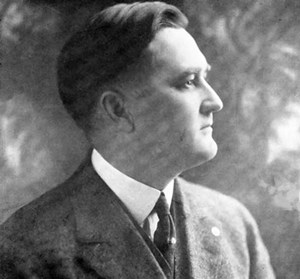The voice of the IPAA rings across the decades
The American economy appeared robust on June 10, 1929, when President Herbert Hoover began a conference aimed at conserving America’s natural petroleum resources. Crude oil production was growing, and increasing volumes were being exported. The newly elected Hoover was being counseled by his Secretary of the Interior that America should turn its attention to the conservation of oil resources before they ran out.
The meeting was contentious, and it was in the tumult that the voice of the soon-to-be Independent Petroleum Association of America (IPAA) was heard loudly in the words of an Oklahoma oilman who would be its first president.
The Hoover Administration had earlier announced that it planned to stop leasing federal lands and would be rescinding leases where development wasn’t being actively undertaken. Western governors and Western producers were outraged. The June meeting at the Broadmoor Hotel in Colorado Springs was the administration’s response.
The list of speakers was impressive, and included Ray Lyman Wilbur, Secretary of the Interior; George Otis Smith, director of the United States Geological Survey; E. B. Reeser, president of the Petroleum Institute; Frank C. Emerson, governor of Wyoming; and Mark L. Requa, permanent chairman of the conference. In addition, the chairmen of delegations from 12 oil-producing states delivered addresses, as well as chairmen representing eight oil and gas associations.
Believing that a further study of the problems would likely attain better results, it was moved that a recess be taken, subject to reassembly upon the call of the President of the United States. The conference was thus adjourned without forming an interstate oil compact, and no recommendation for immediate action was made.
The climax of the conference, from the perspective of the IPAA, was the address delivered by Wirt Franklin of Ardmore, Okla., representing the Southern Oklahoma Oil and Gas Association. He would soon become IPAA’s first president. In his speech, Franklin advocated a tariff on oil. That position, adopted as a resolution prior to the conference, and the message of Franklin’s keynote speech, is summed up in a single sentence: “I believe American markets for crude oil should be kept for the American producer of crude oil.”
Following this conference session, a mass meeting of oil operators, royalty owners, land owners and permit-holders was called, and on Tuesday morning June 11, 1929, they all met at the Antlers Hotel to organize a national association to represent them—the IPAA.
What two dozen determined independent producers started in the summer of 1929 has grown to an organization of thousands today. For 87 years, the IPAA has been on the front lines in its service to, and support of, America’s independent oil and natural gas producers. The association’s past and present volunteer leaders skillfully married business savvy with political willpower to keep the independent producing industry alive through boom and bust.
When the IPAA’s founders returned to Ardmore, after their historic meeting in Colorado Springs, their first task was to find office space and hire a permanent staff. They chose, as one of the principal staff members, someone who understood the oil producing industry as well as he knew law and governmental processes. Russell B. Brown became the IPAA’s first executive manager in 1930.
Later that year, the association moved its headquarters and staff to Tulsa. There wasn’t much or very many to move—Brown and office manager Elinor Huss (Bond) made up the entire group. In Tulsa, Charles E. Bowles was retained as a statistician and public relations specialist, and the third person to join the staff in the IPAA’s three-room headquarters in the Thompson Building.
Following the IPAA’s second annual meeting in Tulsa, in April 1931, Brown became general counsel and moved to Washington, D.C., to set up an office. He stayed there until his 1959 retirement. With Brown’s move to Washington, C. E. Buchner was named executive manager in Tulsa, a position he held until 1954.

The growing IPAA changed Tulsa offices once more in 1949, before construction plans for a new office building took shape in 1953. Until 1971, the association operated out of two offices—one in Tulsa, the other in Washington, D.C. When they were consolidated that year in Washington, the combined staff in 1971 numbered 21. The head count has not changed much; it is only 22 today.
Lloyd Unsell, was the IPAA’s longest serving executive with nearly 40 years at the helm. Unsell, who died in 2007, joined the IPAA staff in 1948 and was put in charge of information programs. He became V.P. for public affairs in 1949, executive V.P. in 1976, and president in 1985.
A former newspaperman, Unsell used his communication skills in preparing countless hundreds of position papers, articles and speeches on U.S. energy policy. Throughout his expansive career, he earned a reputation as a man who put principles above personalities, and one who effectively advocated a position, because he believed in his heart that it was right.
The IPAA also has enjoyed the membership of some uncharacteristic “oilmen” within its ranks, including colorful people like comedian Bob Hope, crooner Bing Crosby and jockey Eddie Arcaro. Arcaro became a member of the IPAA in 1950, because of his petroleum interests in New York. Unsell recalled it was W. A. (Monty) Moncrief of Fort Worth, Texas, who signed Hope and Crosby as partners in a 1949 JV that turned out to be a very lucrative oil discovery—a 100-bbl/hr producer—in Scurry County, Texas.
Unsell also recalled that Hope once brought the entire troupe of performers from his USO shows, including Jerry Colona, Marilyn Maxwell, and the Les Brown Orchestra, to entertain IPAA members at a meeting at Houston’s infamous Shamrock Hotel. When there wasn’t a room large enough to accommodate the entertainers and the audience, Houston members pitched in and rented a circus tent from Ringling Bros.
Following World War II, drilling activity progressed at an unprecedented rate. More than 20,000 wells and 75 MMft of hole were drilled during the first 6 months of 1950. By year-end, the industry was drilling at the rate of 165 MMft/year and had completed more than 41,000 wells. Almost 95% of America’s population was consuming petroleum products.
But it was not to last. From 1956 to 1973, the effect of import regulation on oil and natural gas prices nearly resulted in the dismantling of the domestic oil industry. A U.S. oil surplus was eliminated, and production peaked in 1970, followed by a decline that lasted until 2008.
Price controls rattled the markets, and 1973 saw extreme shortages of gasoline. The 1973 actions of the Organization of the Petroleum Exporting Countries caused many problems for the IPAA and its volunteer leaders.
That same year, the Israeli-Arab conflict led to Arab embargoes on oil shipments, and Senator ‘Scoop’ Jackson began a series of hearings that were severely critical of the domestic oil industry. During these attacks, the IPAA was the only industry spokesman who stood up to Jackson and refuted his disastrously misguided statements.
By the late 1970s, the government changed directions and began to deregulate markets for oil, natural gas and coal. But in the 1980s a “windfall profits” tax was imposed that did not favor domestic production. It was repealed in 1988, although a ban on oil exports lingered on and depressed domestic producer profits until it, too, was lifted in 2015.
The energy crisis of the 1970s was followed by the 1980s oil glut, as global economic activity slowed. The down cycle began a price decline that lasted until 1986, when the price dropped 50%.
The industry faced many complex issues in the 1980s, including natural gas decontrol, Canadian natural gas imports, pipeline rate design, and later the BTU tax, which sought to tax fuel based on its heat content.
During this time, past IPAA chairman George A. Alcorn founded the Natural Gas Council to shape natural gas policy. The council collectively represents the IPAA, the American Gas Association, The American Petroleum Institute, the Interstate Natural Gas Association of America, and the Natural Gas Supply Association.
By 1991, the IPAA was projecting a steeper decline in crude production and pointed to federal policies. Its new chairman, Eugene L. Ames, Jr., of San Antonio, said the U.S. petroleum sector was “an industry under siege” and called for action: “It’s time for the country to wake up and remove government penalties on U.S. producers—penalties that have the same effect as placing embargoes on domestic oil and gas production.”
By the end of the decade, the industry was on the cusp of the shale revolution. In 1998, George P. Mitchell and Mitchell Energy achieved the first viable slickwater shale frac. In 2000, shale gas accounted for just 1% of U.S. gas production; by 2010, it was more than 20%. In the process, independents came to dominate the industry.
Today, the issues addressed daily by the IPAA include leasing on federal lands, industry taxation, endangered species, federal regulations on operations, health and safety, financial records and offshore procedures. Faced with a huge and growing regulatory onslaught, the IPAA remains the industry’s chief advocate. ![]()




